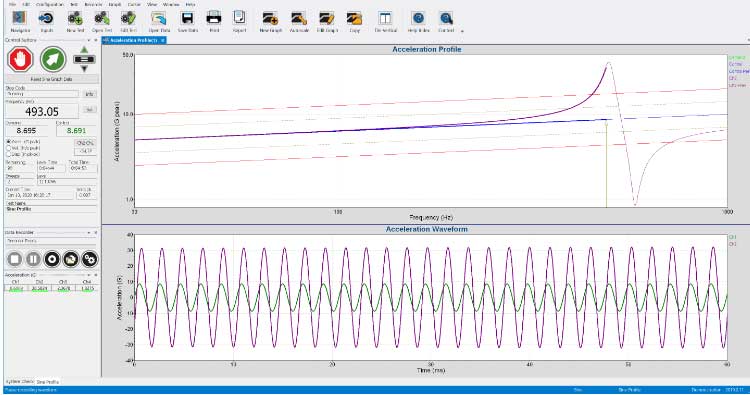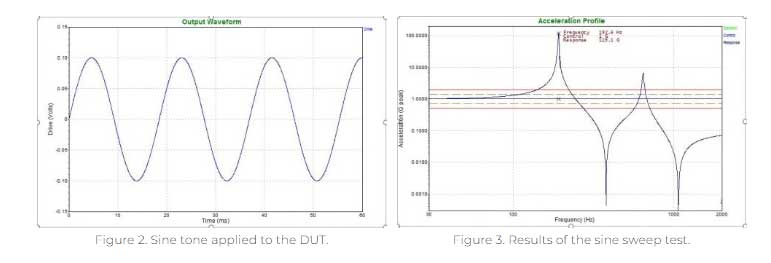Vibration testing is one of the most effective ways to understand the health and durability of a product. Through vibration testing, you can identify and locate defects in these components, understand how different materials respond to environmental pressures, and ensure that products are designed and manufactured for the right operating environment.

Damped vibrations: Damped vibrations occur when forced vibrations are suppressed and eliminated by gravity or friction. Many mechanical components and products are equipped with built-in shock absorbers to minimize exposure to vibration. Shock absorbers in cars, for example, can eliminate vibrations caused by bad driving conditions. Conducting damping vibration tests helps ensure that these products meet their design requirements
Free vibration: Free vibration occurs in response to the inertial force, which will change the energy of the object, resulting in an increase in energy. This vibration will gradually weaken the energy of the measured object until the excess energy is completely dissipated and the object returns to a stable equilibrium state.
Forced vibration: Forced vibration occurs when external alternating forces are applied to a mechanical or structural system. The vibration of a building during an earthquake is a classic example of forced vibration – when an earthquake occurs, the building is driven by external seismic forces, causing its vibration frequency to change. Under the action of the seismic force, the vibration frequency of the building remains stable until the frequency change of the seismic force further affects the building system, and its energy is forced to change.
Vibration testing analyzes vibration patterns within mechanical systems or individual components and structures to identify defects and assess the overall condition of the test object.
Performing vibration testing enables manufacturers and engineers to:
1.Determine product limitations and tolerances
2.To ensure that the product is suitable for its intended use
3.Detects and diagnoses structural or system defects
4.Improve product quality and durability
5.Confirm compliance with quality standards
Random vibration test involves subjecting a product or system to a wide range of vibration frequencies simultaneously, mimicking real-world conditions. It allows engineers to evaluate the response and durability of equipment under unpredictable vibrations encountered during transportation or general use. By definition, the amplitude and phase of this signal are random, just like the vibrations around us, so this type of test can better simulate real-life noise effects.

In contrast to sinusoidal testing, with random testing we can obtain a representation of all frequencies of objects within a specified range. This representation is usually given in the form of PSD (Power spectral density) and frequency plots.

Typical setup for random vibration test
A typical setup for a random vibration test is no different from a standard vibration test device and includes a controller, a shaker or motorized shaker, a power amplifier, and the device under test (DUT) mounted on it. Shaker table produces random vibration with intensity and spectrum control. The response of the DUT is measured using accelerometers or other strategically placed sensing devices to capture critical points of interest.
Sine vibration test exposes the device under test (DUT) to a single frequency sinusoidal tone of a specified amplitude for a period of time. There are several different ways to perform a sine test. Engineers can run a sinusoidal scan to expose the DUT to a single sinusoidal tone that varies in frequency within a specified range.
After performing a sine scan, engineers can determine the resonant frequency of the DUT. They can then expose the DUT to resonant frequencies until a failure occurs or until each resonance takes enough time to ensure that a failure does not occur in the real world.

In Figure 2, the drive waveform shows the individual sinusoidal tone applied to the DUT during a sinusoidal scan test. The acceleration curve in Figure 3 shows the peak amplitude in relation to frequency at two points on the DUT. The control point is the installation point of the DUT, and the response point is the second point on the DUT.

The signal at the resonance _ response point is easy to identify, which is the main purpose of sine testing. The amplification factor of the resonance is usually the cause of DUT failure. Engineers can also design the sinusoidal test to stay at the first large resonance (192.6 Hz) until the DUT fails or until enough time is spent at the resonance to ensure that the DUT does not fail.
The signal driving the oscillator is a clean sinusoidal tone, as shown in Figure 2. The signal measured at the DUT is not always so clean. The measured signal contains harmonics and other sources of mechanical and electrical noise. Sinusoidal testing requires the measurement and control of energy at a single frequency. The tracking filter also needs to remove energy from the measurement except for a single frequency.